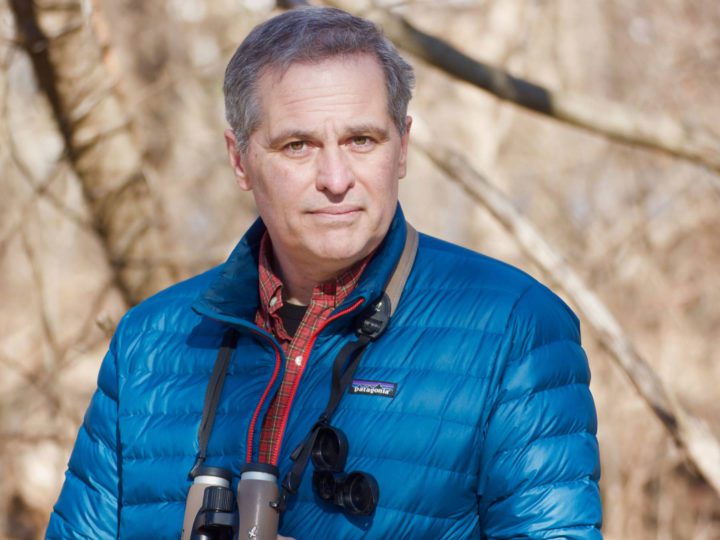Expertise
Administrative Oversight • Fundraising • Board Relations • Evolutionary Ecology • External Communication
As Executive Director I oversee the Lab’s scientific, public, operational, and fundraising programs. I also guide the strategic development of the Lab and relationships with the Lab’s Administrative Board and broader Cornell leadership.
I’m also a professor in the Department of Ecology and Evolutionary Biology, where I advise graduate students. My main research interests are in large-scale patterns in life histories, mating systems, and extinction risk; and evolution in wild populations. We use a combination of field experiments, genetic analyses, and phylogenetic and spatial models. Almost all of my work is based on birds because of the unrivaled depth of information on bird species across the globe, and the way that we can follow free-living individuals through their lives.
To me, birds are a unique tool for understanding how nature works. I also believe that there is a unique relationship between people and birds; birds have the power to inspire us to think about the world around us and care about its future.
I grew up in North Yorkshire, in the UK, and began “serious birding” as a teenager, having been exposed to birdwatching and natural history during family holidays to the mountains and coasts of Scotland and Wales. Since then, I’ve traveled around the world to see and work on birds, and birding is still a huge part of my life. At college I studied zoology and became fascinated by behavioral ecology and evolution. I went on to study evolutionary biology at graduate school, spending the summer months chasing Eurasian Dotterels on the Cairngorm plateau in Scotland in order to better understand their “sex-role reversed” mating system.
Following graduate school, I was fortunate enough to enter a career as a university professor, researching and teaching in universities in the UK and Australia. With an amazing team of students, postdocs, and collaborators we studied a wide range of topics in ecology, evolution, and behavior including the evolution of island species, biodiversity hotspots, coloration, and the genetic benefits of mate choice. A lot of our work involved large multispecies analyses, but we also did in-depth studies of particular species such as the white-eyes of the South West Pacific islands, House Sparrows on Lundy Island, Ruff on Gotland Island, Eurasian Blue Tits at Silwood Park, and invasive Rose-ringed Parakeets in the parks of South West London.
After 20 years as a university academic I decided I wanted to promote scientific understanding amongst much broader public audiences, so I moved to the Natural History Museum in London and then subsequently to the Smithsonian National Museum of Natural History in Washington, DC. Working in natural history museums gave me the chance to learn how to engage the public with topics such as human evolution and climate change, and to develop programs in rapidly developing fields such as large-scale biodiversity data, participatory science, and next-generation genomics. Consequently, when I moved to the Lab in 2021, it felt like the convergence of these two strands of my life; a public-facing scientific institute dedicated to understanding and conserving birds embedded in one of the world’s great research universities.
Education
PhD, University of Leicester
BSc, University of Liverpool
Spark Moment
My life was changed by a close encounter with a Eurasian Marsh-Harrier. At the age of 15 I was working as a voluntary warden at the RSPB’s Snettisham reserve on the UK’s North Norfolk Coast. While I was hunkered down in the saltmarsh a male harrier glided low over my head before swooping up into the sky. I’d never experienced such a visceral sensation, a combination of beauty and power—it left me reeling. The next day a couple of fellow wardens took me to the nearby birding meccas of Cley Marshes and Blakeney Point, where I experienced the emotional roller coaster of seeing a fly-by “bonxie” (Great Skua) and a vagrant Marsh Sandpiper whilst dipping on a Eurasian Dotterel. I was hooked.
Beyond the Lab
Sally and I love the outdoors and traveling, ideally with our two-grown up sons, involving as much hiking, cycling, kayaking, photography and art as we can manage.
Selected Publications
2804417
owens-ian
1
the-auk
50
date
desc
title
11225
https://www.birds.cornell.edu/home/wp-content/plugins/zotpress/
%7B%22status%22%3A%22success%22%2C%22updateneeded%22%3Afalse%2C%22instance%22%3Afalse%2C%22meta%22%3A%7B%22request_last%22%3A0%2C%22request_next%22%3A0%2C%22used_cache%22%3Atrue%7D%2C%22data%22%3A%5B%7B%22key%22%3A%22YBCXE7WV%22%2C%22library%22%3A%7B%22id%22%3A2804417%7D%2C%22meta%22%3A%7B%22creatorSummary%22%3A%22Peck%20et%20al.%22%2C%22parsedDate%22%3A%222014-05-01%22%2C%22numChildren%22%3A2%7D%2C%22bib%22%3A%22%26lt%3Bdiv%20class%3D%26quot%3Bcsl-bib-body%26quot%3B%20style%3D%26quot%3Bline-height%3A%201.35%3B%20padding-left%3A%201em%3B%20text-indent%3A-1em%3B%26quot%3B%26gt%3B%5Cn%20%26lt%3Bdiv%20class%3D%26quot%3Bcsl-entry%26quot%3B%26gt%3BPeck%2C%20H.%20L.%2C%20H.%20E.%20Pringle%2C%20H.%20H.%20Marshall%2C%20I.%20P.%20F.%20Owens%2C%20and%20A.%20M.%20Lord%20%282014%29.%20%26lt%3Ba%20class%3D%26%23039%3Bzp-ItemURL%26%23039%3B%20href%3D%26%23039%3Bhttps%3A%5C%2F%5C%2Fdoi.org%5C%2F10.1093%5C%2Fbeheco%5C%2Faru025%26%23039%3B%26gt%3BExperimental%20evidence%20of%20impacts%20of%20an%20invasive%20parakeet%20on%20foraging%20behavior%20of%20native%20birds%26lt%3B%5C%2Fa%26gt%3B.%20%26lt%3Bi%26gt%3BBehavioral%20Ecology%26lt%3B%5C%2Fi%26gt%3B%2025%3A582%5Cu2013590.%26lt%3B%5C%2Fdiv%26gt%3B%5Cn%26lt%3B%5C%2Fdiv%26gt%3B%22%2C%22data%22%3A%7B%22itemType%22%3A%22journalArticle%22%2C%22title%22%3A%22Experimental%20evidence%20of%20impacts%20of%20an%20invasive%20parakeet%20on%20foraging%20behavior%20of%20native%20birds%22%2C%22creators%22%3A%5B%7B%22creatorType%22%3A%22author%22%2C%22firstName%22%3A%22Hannah%20L.%22%2C%22lastName%22%3A%22Peck%22%7D%2C%7B%22creatorType%22%3A%22author%22%2C%22firstName%22%3A%22Henrietta%20E.%22%2C%22lastName%22%3A%22Pringle%22%7D%2C%7B%22creatorType%22%3A%22author%22%2C%22firstName%22%3A%22Harry%20H.%22%2C%22lastName%22%3A%22Marshall%22%7D%2C%7B%22creatorType%22%3A%22author%22%2C%22firstName%22%3A%22Ian%20P.F.%22%2C%22lastName%22%3A%22Owens%22%7D%2C%7B%22creatorType%22%3A%22author%22%2C%22firstName%22%3A%22Alexa%20M.%22%2C%22lastName%22%3A%22Lord%22%7D%5D%2C%22abstractNote%22%3A%22Resource%20competition%20is%20one%20potential%20behavioral%20mechanism%20by%20which%20invasive%20species%20can%20impact%20native%20species%2C%20but%20detecting%20this%20competition%20can%20be%20difficult%20due%20to%20the%20interactions%20that%20variable%20environmental%20conditions%20can%20have%20on%20species%20behavior.%20This%20is%20particularly%20the%20case%20in%20urban%20habitats%20where%20the%20disturbed%20environment%20can%20alter%20natural%20behavior%20from%20that%20in%20undisturbed%20habitats.%20The%20rose-ringed%20parakeet%20%28Psittacula%20krameri%29%2C%20is%20an%20increasingly%20common%20invasive%20species%2C%20predominantly%20associated%20with%20large%20urban%20centers.%20Using%20an%20experimental%20approach%2C%20we%20tested%20the%20behavioral%20responses%20of%20native%20garden%20birds%20in%20response%20to%20the%20presence%20of%20a%20rose-ringed%20parakeet%20versus%20the%20presence%20of%20a%20similarly%20sized%20and%20dominant%20native%20bird%2C%20the%20great%20spotted%20woodpecker%20%28Dendrocopos%20major%29.%20Parakeet%20presence%20significantly%20reduced%20feeding%20rates%20and%20increased%20vigilance%20among%20native%20birds%20compared%20with%20our%20control%20treatments.%20Of%20visits%20made%20by%20native%20birds%20in%20the%20presence%20of%20a%20parakeet%2C%20feeding%20was%20more%20likely%20to%20occur%20in%20sites%20within%20the%20parakeet%20range%20compared%20with%20sites%20outside%2C%20suggesting%20some%20habituation%20of%20native%20birds%20has%20occurred%20following%20prior%20exposure%20to%20parakeets%20but%20overall%20foraging%20behavior%20is%20still%20disrupted.%20The%20results%20of%20our%20study%20suggest%20that%20nonnative%20species%20can%20have%20complex%20and%20subtle%20impacts%20on%20native%20fauna%20and%20show%20that%20a%20nonnative%20competitor%20can%20impact%20native%20species%20simply%20through%20their%20presence%20near%20resources.%22%2C%22date%22%3A%22May%201%2C%202014%22%2C%22language%22%3A%22%22%2C%22DOI%22%3A%2210.1093%5C%2Fbeheco%5C%2Faru025%22%2C%22ISSN%22%3A%221045-2249%22%2C%22url%22%3A%22https%3A%5C%2F%5C%2Fdoi.org%5C%2F10.1093%5C%2Fbeheco%5C%2Faru025%22%2C%22collections%22%3A%5B%5D%2C%22dateModified%22%3A%222021-06-30T15%3A02%3A48Z%22%7D%7D%2C%7B%22key%22%3A%22DAYKXHAD%22%2C%22library%22%3A%7B%22id%22%3A2804417%7D%2C%22meta%22%3A%7B%22creatorSummary%22%3A%22Bell%20et%20al.%22%2C%22parsedDate%22%3A%222014-03-01%22%2C%22numChildren%22%3A2%7D%2C%22bib%22%3A%22%26lt%3Bdiv%20class%3D%26quot%3Bcsl-bib-body%26quot%3B%20style%3D%26quot%3Bline-height%3A%201.35%3B%20padding-left%3A%201em%3B%20text-indent%3A-1em%3B%26quot%3B%26gt%3B%5Cn%20%26lt%3Bdiv%20class%3D%26quot%3Bcsl-entry%26quot%3B%26gt%3BBell%2C%20S.%20C.%2C%20I.%20P.%20F.%20Owens%2C%20and%20A.%20M.%20Lord%20%282014%29.%20%26lt%3Ba%20class%3D%26%23039%3Bzp-ItemURL%26%23039%3B%20href%3D%26%23039%3Bhttps%3A%5C%2F%5C%2Fdoi.org%5C%2F10.1093%5C%2Fbeheco%5C%2Fart112%26%23039%3B%26gt%3BQuality%20of%20breeding%20territory%20mediates%20the%20influence%20of%20paternal%20quality%20on%20sex%20ratio%20bias%20in%20a%20free-living%20bird%20population%26lt%3B%5C%2Fa%26gt%3B.%20%26lt%3Bi%26gt%3BBehavioral%20Ecology%26lt%3B%5C%2Fi%26gt%3B%2025%3A352%5Cu2013358.%26lt%3B%5C%2Fdiv%26gt%3B%5Cn%26lt%3B%5C%2Fdiv%26gt%3B%22%2C%22data%22%3A%7B%22itemType%22%3A%22journalArticle%22%2C%22title%22%3A%22Quality%20of%20breeding%20territory%20mediates%20the%20influence%20of%20paternal%20quality%20on%20sex%20ratio%20bias%20in%20a%20free-living%20bird%20population%22%2C%22creators%22%3A%5B%7B%22creatorType%22%3A%22author%22%2C%22firstName%22%3A%22Sophie%20C.%22%2C%22lastName%22%3A%22Bell%22%7D%2C%7B%22creatorType%22%3A%22author%22%2C%22firstName%22%3A%22Ian%20P.F.%22%2C%22lastName%22%3A%22Owens%22%7D%2C%7B%22creatorType%22%3A%22author%22%2C%22firstName%22%3A%22Alexa%20M.%22%2C%22lastName%22%3A%22Lord%22%7D%5D%2C%22abstractNote%22%3A%22Sex%20allocation%20theory%20predicts%20that%20females%20will%20invest%20more%20in%20offspring%20of%20the%20sex%20that%20offers%20a%20higher%20fitness%20potential.%20Male%20offspring%20should%20be%20favored%20where%20direct%20genetic%20benefits%20from%20the%20father%20or%20indirect%20benefits%20from%20the%20parents%20or%20environment%20are%20likely%20to%20result%20in%20higher%20than%20average%20quality%20offspring.%20In%20birds%2C%20sex%20allocation%20has%20previously%20been%20linked%20to%20paternal%20quality%20and%20sexual%20attractiveness%2C%20but%20the%20potential%20importance%20of%20breeding%20territory%20quality%20has%20been%20largely%20overlooked.%20Using%20a%20wild%20population%20of%20a%20territorial%20bird%20species%2C%20the%20blue%20tit%20%28Cyanistes%20caeruleus%29%2C%20we%20show%20that%20variation%20in%20sex%20ratio%20is%20associated%20with%20paternal%20quality%2C%20but%20that%20the%20relationship%20hinges%20on%20the%20quality%20of%20the%20breeding%20territory.%20Among%20broods%20in%20high-quality%20territories%2C%20there%20is%20a%20positive%20association%20between%20primary%20sex%20ratio%20and%20male%20mate%20condition%2C%20which%20is%20not%20found%20among%20broods%20in%20low-quality%20territories.%20In%20turn%2C%20we%20find%20that%20paternal%20quality%20as%20opposed%20to%20maternal%20quality%20is%20associated%20with%20chick%20recruitment%20and%20that%20the%20condition%20of%20the%20chick%20is%20predicted%20by%20an%20interaction%20of%20parental%20and%20territory%20quality%2C%20reflecting%20the%20trend%20in%20primary%20sex%20ratio%20bias%20observed%20in%20our%20system.%20These%20results%20suggest%20that%20sex%20allocation%20is%20influenced%20not%20only%20by%20variation%20in%20the%20quality%20of%20the%20father%20but%20also%20by%20differences%20between%20territories%20in%20the%20resources%20available%20for%20breeding%2C%20which%20in%20turn%20suggests%20an%20interaction%20between%20genetic%20and%20environmental%20effects.%22%2C%22date%22%3A%22March%201%2C%202014%22%2C%22language%22%3A%22%22%2C%22DOI%22%3A%2210.1093%5C%2Fbeheco%5C%2Fart112%22%2C%22ISSN%22%3A%221045-2249%22%2C%22url%22%3A%22https%3A%5C%2F%5C%2Fdoi.org%5C%2F10.1093%5C%2Fbeheco%5C%2Fart112%22%2C%22collections%22%3A%5B%5D%2C%22dateModified%22%3A%222021-06-30T15%3A03%3A46Z%22%7D%7D%2C%7B%22key%22%3A%22C6MU5I7D%22%2C%22library%22%3A%7B%22id%22%3A2804417%7D%2C%22meta%22%3A%7B%22creatorSummary%22%3A%22Pigot%20et%20al.%22%2C%22parsedDate%22%3A%222012-02-21%22%2C%22numChildren%22%3A2%7D%2C%22bib%22%3A%22%26lt%3Bdiv%20class%3D%26quot%3Bcsl-bib-body%26quot%3B%20style%3D%26quot%3Bline-height%3A%201.35%3B%20padding-left%3A%201em%3B%20text-indent%3A-1em%3B%26quot%3B%26gt%3B%5Cn%20%26lt%3Bdiv%20class%3D%26quot%3Bcsl-entry%26quot%3B%26gt%3BPigot%2C%20A.%20L.%2C%20I.%20P.%20F.%20Owens%2C%20and%20C.%20D.%20L.%20Orme%20%282012%29.%20%26lt%3Ba%20class%3D%26%23039%3Bzp-ItemURL%26%23039%3B%20href%3D%26%23039%3Bhttps%3A%5C%2F%5C%2Fjournals.plos.org%5C%2Fplosbiology%5C%2Farticle%3Fid%3D10.1371%5C%2Fjournal.pbio.1001260%26%23039%3B%26gt%3BSpeciation%20and%20Extinction%20Drive%20the%20Appearance%20of%20Directional%20Range%20Size%20Evolution%20in%20Phylogenies%20and%20the%20Fossil%20Record%26lt%3B%5C%2Fa%26gt%3B.%20%26lt%3Bi%26gt%3BPLOS%20Biology%26lt%3B%5C%2Fi%26gt%3B%2010%3Ae1001260.%26lt%3B%5C%2Fdiv%26gt%3B%5Cn%26lt%3B%5C%2Fdiv%26gt%3B%22%2C%22data%22%3A%7B%22itemType%22%3A%22journalArticle%22%2C%22title%22%3A%22Speciation%20and%20Extinction%20Drive%20the%20Appearance%20of%20Directional%20Range%20Size%20Evolution%20in%20Phylogenies%20and%20the%20Fossil%20Record%22%2C%22creators%22%3A%5B%7B%22creatorType%22%3A%22author%22%2C%22firstName%22%3A%22Alex%20L.%22%2C%22lastName%22%3A%22Pigot%22%7D%2C%7B%22creatorType%22%3A%22author%22%2C%22firstName%22%3A%22Ian%20P.%20F.%22%2C%22lastName%22%3A%22Owens%22%7D%2C%7B%22creatorType%22%3A%22author%22%2C%22firstName%22%3A%22C.%20David%20L.%22%2C%22lastName%22%3A%22Orme%22%7D%5D%2C%22abstractNote%22%3A%22The%20appearance%20of%20directional%20trends%20in%20the%20evolution%20of%20species%20range%20sizes%20can%20arise%20from%20stochastic%20models%20and%20need%20not%20imply%20the%20existence%20of%20underlying%20trends.%22%2C%22date%22%3A%22Feb%2021%2C%202012%22%2C%22language%22%3A%22en%22%2C%22DOI%22%3A%2210.1371%5C%2Fjournal.pbio.1001260%22%2C%22ISSN%22%3A%221545-7885%22%2C%22url%22%3A%22https%3A%5C%2F%5C%2Fjournals.plos.org%5C%2Fplosbiology%5C%2Farticle%3Fid%3D10.1371%5C%2Fjournal.pbio.1001260%22%2C%22collections%22%3A%5B%5D%2C%22dateModified%22%3A%222021-06-30T15%3A06%3A12Z%22%7D%7D%2C%7B%22key%22%3A%223WTM3BLN%22%2C%22library%22%3A%7B%22id%22%3A2804417%7D%2C%22meta%22%3A%7B%22creatorSummary%22%3A%22Jenkins%20et%20al.%22%2C%22parsedDate%22%3A%222012%22%2C%22numChildren%22%3A2%7D%2C%22bib%22%3A%22%26lt%3Bdiv%20class%3D%26quot%3Bcsl-bib-body%26quot%3B%20style%3D%26quot%3Bline-height%3A%201.35%3B%20padding-left%3A%201em%3B%20text-indent%3A-1em%3B%26quot%3B%26gt%3B%5Cn%20%26lt%3Bdiv%20class%3D%26quot%3Bcsl-entry%26quot%3B%26gt%3BJenkins%2C%20T.%2C%20G.%20H.%20Thomas%2C%20O.%20Hellgren%2C%20and%20I.%20P.%20F.%20Owens%20%282012%29.%20%26lt%3Ba%20class%3D%26%23039%3Bzp-ItemURL%26%23039%3B%20href%3D%26%23039%3Bhttps%3A%5C%2F%5C%2Fonlinelibrary.wiley.com%5C%2Fdoi%5C%2Fabs%5C%2F10.1111%5C%2Fj.1558-5646.2011.01470.x%26%23039%3B%26gt%3BMigratory%20Behavior%20of%20Birds%20Affects%20Their%20Coevolutionary%20Relationship%20with%20Blood%20Parasites%26lt%3B%5C%2Fa%26gt%3B.%20%26lt%3Bi%26gt%3BEvolution%26lt%3B%5C%2Fi%26gt%3B%2066%3A740%5Cu2013751.%26lt%3B%5C%2Fdiv%26gt%3B%5Cn%26lt%3B%5C%2Fdiv%26gt%3B%22%2C%22data%22%3A%7B%22itemType%22%3A%22journalArticle%22%2C%22title%22%3A%22Migratory%20Behavior%20of%20Birds%20Affects%20Their%20Coevolutionary%20Relationship%20with%20Blood%20Parasites%22%2C%22creators%22%3A%5B%7B%22creatorType%22%3A%22author%22%2C%22firstName%22%3A%22Tania%22%2C%22lastName%22%3A%22Jenkins%22%7D%2C%7B%22creatorType%22%3A%22author%22%2C%22firstName%22%3A%22Gavin%20H.%22%2C%22lastName%22%3A%22Thomas%22%7D%2C%7B%22creatorType%22%3A%22author%22%2C%22firstName%22%3A%22Olof%22%2C%22lastName%22%3A%22Hellgren%22%7D%2C%7B%22creatorType%22%3A%22author%22%2C%22firstName%22%3A%22Ian%20P.%20F.%22%2C%22lastName%22%3A%22Owens%22%7D%5D%2C%22abstractNote%22%3A%22Host%20traits%2C%20such%20as%20migratory%20behavior%2C%20could%20facilitate%20the%20dispersal%20of%20disease-causing%20parasites%2C%20potentially%20leading%20to%20the%20transfer%20of%20infections%20both%20across%20geographic%20areas%20and%20between%20host%20species.%20There%20is%2C%20however%2C%20little%20quantitative%20information%20on%20whether%20variation%20in%20such%20host%20attributes%20does%20indeed%20affect%20the%20evolutionary%20outcome%20of%20host%5Cu2013parasite%20associations.%20Here%2C%20we%20employ%20Leucocytozoon%20blood%20parasites%20of%20birds%2C%20a%20group%20of%20parasites%20closely%20related%20to%20avian%20malaria%2C%20to%20study%20host%5Cu2013parasite%20coevolution%20in%20relation%20to%20host%20behavior%20using%20a%20phylogenetic%20comparative%20approach.%20We%20reconstruct%20the%20molecular%20phylogenies%20of%20both%20the%20hosts%20and%20parasites%20and%20use%20cophylogenetic%20tools%20to%20assess%20whether%20each%20host%5Cu2013parasite%20association%20contributes%20significantly%20to%20the%20overall%20congruence%20between%20the%20two%20phylogenies.%20We%20find%20evidence%20for%20a%20significant%20fit%20between%20host%20and%20parasite%20phylogenies%20in%20this%20system%2C%20but%20show%20that%20this%20is%20due%20only%20to%20associations%20between%20nonmigrant%20parasites%20and%20their%20hosts.%20We%20also%20show%20that%20migrant%20bird%20species%20harbor%20a%20greater%20genetic%20diversity%20of%20parasites%20compared%20with%20nonmigrant%20species.%20Taken%20together%2C%20these%20results%20suggest%20that%20the%20migratory%20habits%20of%20birds%20could%20influence%20their%20coevolutionary%20relationship%20with%20their%20parasites%2C%20and%20that%20consideration%20of%20host%20traits%20is%20important%20in%20predicting%20the%20outcome%20of%20coevolutionary%20interactions.%22%2C%22date%22%3A%222012%22%2C%22language%22%3A%22en%22%2C%22DOI%22%3A%2210.1111%5C%2Fj.1558-5646.2011.01470.x%22%2C%22ISSN%22%3A%221558-5646%22%2C%22url%22%3A%22https%3A%5C%2F%5C%2Fonlinelibrary.wiley.com%5C%2Fdoi%5C%2Fabs%5C%2F10.1111%5C%2Fj.1558-5646.2011.01470.x%22%2C%22collections%22%3A%5B%5D%2C%22dateModified%22%3A%222021-06-30T15%3A04%3A44Z%22%7D%7D%2C%7B%22key%22%3A%225A9MBWN3%22%2C%22library%22%3A%7B%22id%22%3A2804417%7D%2C%22meta%22%3A%7B%22creatorSummary%22%3A%22Olson%20et%20al.%22%2C%22parsedDate%22%3A%222009%22%2C%22numChildren%22%3A2%7D%2C%22bib%22%3A%22%26lt%3Bdiv%20class%3D%26quot%3Bcsl-bib-body%26quot%3B%20style%3D%26quot%3Bline-height%3A%201.35%3B%20padding-left%3A%201em%3B%20text-indent%3A-1em%3B%26quot%3B%26gt%3B%5Cn%20%26lt%3Bdiv%20class%3D%26quot%3Bcsl-entry%26quot%3B%26gt%3BOlson%2C%20V.%20A.%2C%20R.%20G.%20Davies%2C%20C.%20D.%20L.%20Orme%2C%20G.%20H.%20Thomas%2C%20S.%20Meiri%2C%20T.%20M.%20Blackburn%2C%20K.%20J.%20Gaston%2C%20I.%20P.%20F.%20Owens%2C%20and%20P.%20M.%20Bennett%20%282009%29.%20%26lt%3Ba%20class%3D%26%23039%3Bzp-ItemURL%26%23039%3B%20href%3D%26%23039%3Bhttps%3A%5C%2F%5C%2Fonlinelibrary.wiley.com%5C%2Fdoi%5C%2Fabs%5C%2F10.1111%5C%2Fj.1461-0248.2009.01281.x%26%23039%3B%26gt%3BGlobal%20biogeography%20and%20ecology%20of%20body%20size%20in%20birds%26lt%3B%5C%2Fa%26gt%3B.%20%26lt%3Bi%26gt%3BEcology%20Letters%26lt%3B%5C%2Fi%26gt%3B%2012%3A249%5Cu2013259.%26lt%3B%5C%2Fdiv%26gt%3B%5Cn%26lt%3B%5C%2Fdiv%26gt%3B%22%2C%22data%22%3A%7B%22itemType%22%3A%22journalArticle%22%2C%22title%22%3A%22Global%20biogeography%20and%20ecology%20of%20body%20size%20in%20birds%22%2C%22creators%22%3A%5B%7B%22creatorType%22%3A%22author%22%2C%22firstName%22%3A%22Val%5Cu00e9rie%20A.%22%2C%22lastName%22%3A%22Olson%22%7D%2C%7B%22creatorType%22%3A%22author%22%2C%22firstName%22%3A%22Richard%20G.%22%2C%22lastName%22%3A%22Davies%22%7D%2C%7B%22creatorType%22%3A%22author%22%2C%22firstName%22%3A%22C.%20David%20L.%22%2C%22lastName%22%3A%22Orme%22%7D%2C%7B%22creatorType%22%3A%22author%22%2C%22firstName%22%3A%22Gavin%20H.%22%2C%22lastName%22%3A%22Thomas%22%7D%2C%7B%22creatorType%22%3A%22author%22%2C%22firstName%22%3A%22Shai%22%2C%22lastName%22%3A%22Meiri%22%7D%2C%7B%22creatorType%22%3A%22author%22%2C%22firstName%22%3A%22Tim%20M.%22%2C%22lastName%22%3A%22Blackburn%22%7D%2C%7B%22creatorType%22%3A%22author%22%2C%22firstName%22%3A%22Kevin%20J.%22%2C%22lastName%22%3A%22Gaston%22%7D%2C%7B%22creatorType%22%3A%22author%22%2C%22firstName%22%3A%22Ian%20P.%20F.%22%2C%22lastName%22%3A%22Owens%22%7D%2C%7B%22creatorType%22%3A%22author%22%2C%22firstName%22%3A%22Peter%20M.%22%2C%22lastName%22%3A%22Bennett%22%7D%5D%2C%22abstractNote%22%3A%22In%201847%2C%20Karl%20Bergmann%20proposed%20that%20temperature%20gradients%20are%20the%20key%20to%20understanding%20geographic%20variation%20in%20the%20body%20sizes%20of%20warm-blooded%20animals.%20Yet%20both%20the%20geographic%20patterns%20of%20body-size%20variation%20and%20their%20underlying%20mechanisms%20remain%20controversial.%20Here%2C%20we%20conduct%20the%20first%20assemblage-level%20global%20examination%20of%20%5Cu2018Bergmann%5Cu2019s%20rule%5Cu2019%20within%20an%20entire%20animal%20class.%20We%20generate%20global%20maps%20of%20avian%20body%20size%20and%20demonstrate%20a%20general%20pattern%20of%20larger%20body%20sizes%20at%20high%20latitudes%2C%20conforming%20to%20Bergmann%5Cu2019s%20rule.%20We%20also%20show%2C%20however%2C%20that%20median%20body%20size%20within%20assemblages%20is%20systematically%20large%20on%20islands%20and%20small%20in%20species-rich%20areas.%20Similarly%2C%20while%20spatial%20models%20show%20that%20temperature%20is%20the%20single%20strongest%20environmental%20correlate%20of%20body%20size%2C%20there%20are%20secondary%20correlations%20with%20resource%20availability%20and%20a%20strong%20pattern%20of%20decreasing%20body%20size%20with%20increasing%20species%20richness.%20Finally%2C%20our%20results%20suggest%20that%20geographic%20patterns%20of%20body%20size%20are%20caused%20both%20by%20adaptation%20within%20lineages%2C%20as%20invoked%20by%20Bergmann%2C%20and%20by%20taxonomic%20turnover%20among%20lineages.%20Taken%20together%2C%20these%20results%20indicate%20that%20while%20Bergmann%5Cu2019s%20prediction%20based%20on%20physiological%20scaling%20is%20remarkably%20accurate%2C%20it%20is%20far%20from%20the%20full%20picture.%20Global%20patterns%20of%20body%20size%20in%20avian%20assemblages%20are%20driven%20by%20interactions%20between%20the%20physiological%20demands%20of%20the%20environment%2C%20resource%20availability%2C%20species%20richness%20and%20taxonomic%20turnover%20among%20lineages.%22%2C%22date%22%3A%222009%22%2C%22language%22%3A%22en%22%2C%22DOI%22%3A%2210.1111%5C%2Fj.1461-0248.2009.01281.x%22%2C%22ISSN%22%3A%221461-0248%22%2C%22url%22%3A%22https%3A%5C%2F%5C%2Fonlinelibrary.wiley.com%5C%2Fdoi%5C%2Fabs%5C%2F10.1111%5C%2Fj.1461-0248.2009.01281.x%22%2C%22collections%22%3A%5B%5D%2C%22dateModified%22%3A%222021-06-30T15%3A07%3A59Z%22%7D%7D%2C%7B%22key%22%3A%22FBB46AGU%22%2C%22library%22%3A%7B%22id%22%3A2804417%7D%2C%22meta%22%3A%7B%22creatorSummary%22%3A%22Clegg%20et%20al.%22%2C%22parsedDate%22%3A%222008%22%2C%22numChildren%22%3A2%7D%2C%22bib%22%3A%22%26lt%3Bdiv%20class%3D%26quot%3Bcsl-bib-body%26quot%3B%20style%3D%26quot%3Bline-height%3A%201.35%3B%20padding-left%3A%201em%3B%20text-indent%3A-1em%3B%26quot%3B%26gt%3B%5Cn%20%26lt%3Bdiv%20class%3D%26quot%3Bcsl-entry%26quot%3B%26gt%3BClegg%2C%20S.%20M.%2C%20F.%20D.%20Frentiu%2C%20J.%20Kikkawa%2C%20G.%20Tavecchia%2C%20and%20I.%20P.%20F.%20Owens%20%282008%29.%20%26lt%3Ba%20class%3D%26%23039%3Bzp-ItemURL%26%23039%3B%20href%3D%26%23039%3Bhttps%3A%5C%2F%5C%2Fonlinelibrary.wiley.com%5C%2Fdoi%5C%2Fabs%5C%2F10.1111%5C%2Fj.1558-5646.2008.00437.x%26%23039%3B%26gt%3B4000%20Years%20of%20Phenotypic%20Change%20in%20an%20Island%20Bird%3A%20Heterogeneity%20of%20Selection%20Over%20Three%20Microevolutionary%20Timescales%26lt%3B%5C%2Fa%26gt%3B.%20%26lt%3Bi%26gt%3BEvolution%26lt%3B%5C%2Fi%26gt%3B%2062%3A2393%5Cu20132410.%26lt%3B%5C%2Fdiv%26gt%3B%5Cn%26lt%3B%5C%2Fdiv%26gt%3B%22%2C%22data%22%3A%7B%22itemType%22%3A%22journalArticle%22%2C%22title%22%3A%224000%20Years%20of%20Phenotypic%20Change%20in%20an%20Island%20Bird%3A%20Heterogeneity%20of%20Selection%20Over%20Three%20Microevolutionary%20Timescales%22%2C%22creators%22%3A%5B%7B%22creatorType%22%3A%22author%22%2C%22firstName%22%3A%22Sonya%20M.%22%2C%22lastName%22%3A%22Clegg%22%7D%2C%7B%22creatorType%22%3A%22author%22%2C%22firstName%22%3A%22Francesca%20D.%22%2C%22lastName%22%3A%22Frentiu%22%7D%2C%7B%22creatorType%22%3A%22author%22%2C%22firstName%22%3A%22Jiro%22%2C%22lastName%22%3A%22Kikkawa%22%7D%2C%7B%22creatorType%22%3A%22author%22%2C%22firstName%22%3A%22Giacomo%22%2C%22lastName%22%3A%22Tavecchia%22%7D%2C%7B%22creatorType%22%3A%22author%22%2C%22firstName%22%3A%22Ian%20P.%20F.%22%2C%22lastName%22%3A%22Owens%22%7D%5D%2C%22abstractNote%22%3A%22Pronounced%20phenotypic%20shifts%20in%20island%20populations%20are%20typically%20attributed%20to%20natural%20selection%2C%20but%20reconstructing%20heterogeneity%20in%20long-term%20selective%20regimes%20remains%20a%20challenge.%20We%20examined%20a%20scenario%20of%20divergence%20proposed%20for%20species%20colonizing%20a%20new%20environment%2C%20involving%20directional%20selection%20with%20a%20rapid%20shift%20to%20a%20new%20optimum%20and%20subsequent%20stabilization.%20We%20provide%20some%20of%20the%20first%20empirical%20evidence%20for%20this%20model%20of%20evolution%20using%20morphological%20data%20from%20three%20timescales%20in%20an%20island%20bird%2C%20Zosterops%20lateralis%20chlorocephalus.%20In%20less%20than%20four%20millennia%20since%20separation%20from%20its%20mainland%20counterpart%2C%20a%20substantial%20increase%20in%20body%20size%20has%20occurred%20and%20was%20probably%20achieved%20in%20fewer%20than%20500%20generations%20after%20colonization.%20Over%20four%20recent%20decades%2C%20morphological%20traits%20have%20fluctuated%20in%20size%20but%20showed%20no%20significant%20directional%20trends%2C%20suggesting%20maintenance%20of%20a%20relatively%20stable%20phenotype.%20Finally%2C%20estimates%20of%20contemporary%20selection%20gradients%20indicated%20generally%20weak%20directional%20selection.%20These%20results%20provide%20a%20rare%20description%20of%20heterogeneity%20in%20long-term%20natural%20regimes%2C%20and%20caution%20that%20observations%20of%20current%20selection%20may%20be%20of%20limited%20value%20in%20inferring%20mechanisms%20of%20past%20adaptation%20due%20to%20a%20lack%20of%20constancy%20even%20over%20short%20time-frames.%22%2C%22date%22%3A%222008%22%2C%22language%22%3A%22en%22%2C%22DOI%22%3A%2210.1111%5C%2Fj.1558-5646.2008.00437.x%22%2C%22ISSN%22%3A%221558-5646%22%2C%22url%22%3A%22https%3A%5C%2F%5C%2Fonlinelibrary.wiley.com%5C%2Fdoi%5C%2Fabs%5C%2F10.1111%5C%2Fj.1558-5646.2008.00437.x%22%2C%22collections%22%3A%5B%5D%2C%22dateModified%22%3A%222021-06-30T15%3A48%3A38Z%22%7D%7D%2C%7B%22key%22%3A%229RX6HD28%22%2C%22library%22%3A%7B%22id%22%3A2804417%7D%2C%22meta%22%3A%7B%22creatorSummary%22%3A%22Grenyer%20et%20al.%22%2C%22parsedDate%22%3A%222006-11%22%2C%22numChildren%22%3A1%7D%2C%22bib%22%3A%22%26lt%3Bdiv%20class%3D%26quot%3Bcsl-bib-body%26quot%3B%20style%3D%26quot%3Bline-height%3A%201.35%3B%20padding-left%3A%201em%3B%20text-indent%3A-1em%3B%26quot%3B%26gt%3B%5Cn%20%26lt%3Bdiv%20class%3D%26quot%3Bcsl-entry%26quot%3B%26gt%3BGrenyer%2C%20R.%2C%20C.%20D.%20L.%20Orme%2C%20S.%20F.%20Jackson%2C%20G.%20H.%20Thomas%2C%20R.%20G.%20Davies%2C%20T.%20J.%20Davies%2C%20K.%20E.%20Jones%2C%20V.%20A.%20Olson%2C%20R.%20S.%20Ridgely%2C%20P.%20C.%20Rasmussen%2C%20T.-S.%20Ding%2C%20et%20al.%20%282006%29.%20%26lt%3Ba%20class%3D%26%23039%3Bzp-ItemURL%26%23039%3B%20href%3D%26%23039%3Bhttps%3A%5C%2F%5C%2Fwww.nature.com%5C%2Farticles%5C%2Fnature05237%26%23039%3B%26gt%3BGlobal%20distribution%20and%20conservation%20of%20rare%20and%20threatened%20vertebrates%26lt%3B%5C%2Fa%26gt%3B.%20%26lt%3Bi%26gt%3BNature%26lt%3B%5C%2Fi%26gt%3B%20444%3A93%5Cu201396.%26lt%3B%5C%2Fdiv%26gt%3B%5Cn%26lt%3B%5C%2Fdiv%26gt%3B%22%2C%22data%22%3A%7B%22itemType%22%3A%22journalArticle%22%2C%22title%22%3A%22Global%20distribution%20and%20conservation%20of%20rare%20and%20threatened%20vertebrates%22%2C%22creators%22%3A%5B%7B%22creatorType%22%3A%22author%22%2C%22firstName%22%3A%22Richard%22%2C%22lastName%22%3A%22Grenyer%22%7D%2C%7B%22creatorType%22%3A%22author%22%2C%22firstName%22%3A%22C.%20David%20L.%22%2C%22lastName%22%3A%22Orme%22%7D%2C%7B%22creatorType%22%3A%22author%22%2C%22firstName%22%3A%22Sarah%20F.%22%2C%22lastName%22%3A%22Jackson%22%7D%2C%7B%22creatorType%22%3A%22author%22%2C%22firstName%22%3A%22Gavin%20H.%22%2C%22lastName%22%3A%22Thomas%22%7D%2C%7B%22creatorType%22%3A%22author%22%2C%22firstName%22%3A%22Richard%20G.%22%2C%22lastName%22%3A%22Davies%22%7D%2C%7B%22creatorType%22%3A%22author%22%2C%22firstName%22%3A%22T.%20Jonathan%22%2C%22lastName%22%3A%22Davies%22%7D%2C%7B%22creatorType%22%3A%22author%22%2C%22firstName%22%3A%22Kate%20E.%22%2C%22lastName%22%3A%22Jones%22%7D%2C%7B%22creatorType%22%3A%22author%22%2C%22firstName%22%3A%22Valerie%20A.%22%2C%22lastName%22%3A%22Olson%22%7D%2C%7B%22creatorType%22%3A%22author%22%2C%22firstName%22%3A%22Robert%20S.%22%2C%22lastName%22%3A%22Ridgely%22%7D%2C%7B%22creatorType%22%3A%22author%22%2C%22firstName%22%3A%22Pamela%20C.%22%2C%22lastName%22%3A%22Rasmussen%22%7D%2C%7B%22creatorType%22%3A%22author%22%2C%22firstName%22%3A%22Tzung-Su%22%2C%22lastName%22%3A%22Ding%22%7D%2C%7B%22creatorType%22%3A%22author%22%2C%22firstName%22%3A%22Peter%20M.%22%2C%22lastName%22%3A%22Bennett%22%7D%2C%7B%22creatorType%22%3A%22author%22%2C%22firstName%22%3A%22Tim%20M.%22%2C%22lastName%22%3A%22Blackburn%22%7D%2C%7B%22creatorType%22%3A%22author%22%2C%22firstName%22%3A%22Kevin%20J.%22%2C%22lastName%22%3A%22Gaston%22%7D%2C%7B%22creatorType%22%3A%22author%22%2C%22firstName%22%3A%22John%20L.%22%2C%22lastName%22%3A%22Gittleman%22%7D%2C%7B%22creatorType%22%3A%22author%22%2C%22firstName%22%3A%22Ian%20P.%20F.%22%2C%22lastName%22%3A%22Owens%22%7D%5D%2C%22abstractNote%22%3A%22%26%23039%3BSilver%20bullet%26%23039%3B%20conservation%20strategies%20assume%20that%20the%20distribution%20of%20extinction-prone%20species%20in%20one%20well%20studied%20taxonomic%20group%20will%20predict%20the%20distribution%20of%20comparable%20species%20in%20other%20groups.%20This%20has%20been%20hard%20to%20test%2C%20but%20the%20availability%20of%20new%20databases%20on%20the%20global%20distribution%20of%20birds%2C%20mammals%20and%20amphibians%20means%20that%20a%20test%20is%20now%20possible.%20The%20three%20groups%20show%20similar%20patterns%20in%20terms%20of%20overall%20species%20richness%2C%20but%20the%20distribution%20of%20threatened%20and%20rare%20species%20is%20different%20in%20each%20group.%20Silver%20bullet%20strategies%20alone%2C%20it%20seems%2C%20miss%20the%20target.%20Instead%2C%20priority%20areas%20for%20biodiversity%20conservation%20must%20be%20based%20on%20high-resolution%20data%20from%20multiple%20taxa.%22%2C%22date%22%3A%222006-11%22%2C%22language%22%3A%22en%22%2C%22DOI%22%3A%2210.1038%5C%2Fnature05237%22%2C%22ISSN%22%3A%221476-4687%22%2C%22url%22%3A%22https%3A%5C%2F%5C%2Fwww.nature.com%5C%2Farticles%5C%2Fnature05237%22%2C%22collections%22%3A%5B%5D%2C%22dateModified%22%3A%222021-06-30T15%3A50%3A04Z%22%7D%7D%2C%7B%22key%22%3A%22RIU3HRFJ%22%2C%22library%22%3A%7B%22id%22%3A2804417%7D%2C%22meta%22%3A%7B%22creatorSummary%22%3A%22Orme%20et%20al.%22%2C%22parsedDate%22%3A%222006-06-20%22%2C%22numChildren%22%3A2%7D%2C%22bib%22%3A%22%26lt%3Bdiv%20class%3D%26quot%3Bcsl-bib-body%26quot%3B%20style%3D%26quot%3Bline-height%3A%201.35%3B%20padding-left%3A%201em%3B%20text-indent%3A-1em%3B%26quot%3B%26gt%3B%5Cn%20%26lt%3Bdiv%20class%3D%26quot%3Bcsl-entry%26quot%3B%26gt%3BOrme%2C%20C.%20D.%20L.%2C%20R.%20G.%20Davies%2C%20V.%20A.%20Olson%2C%20G.%20H.%20Thomas%2C%20T.-S.%20Ding%2C%20P.%20C.%20Rasmussen%2C%20R.%20S.%20Ridgely%2C%20A.%20J.%20Stattersfield%2C%20P.%20M.%20Bennett%2C%20I.%20P.%20F.%20Owens%2C%20T.%20M.%20Blackburn%2C%20and%20K.%20J.%20Gaston%20%282006%29.%20%26lt%3Ba%20class%3D%26%23039%3Bzp-ItemURL%26%23039%3B%20href%3D%26%23039%3Bhttps%3A%5C%2F%5C%2Fjournals.plos.org%5C%2Fplosbiology%5C%2Farticle%3Fid%3D10.1371%5C%2Fjournal.pbio.0040208%26%23039%3B%26gt%3BGlobal%20Patterns%20of%20Geographic%20Range%20Size%20in%20Birds%26lt%3B%5C%2Fa%26gt%3B.%20%26lt%3Bi%26gt%3BPLOS%20Biology%26lt%3B%5C%2Fi%26gt%3B%204%3Ae208.%26lt%3B%5C%2Fdiv%26gt%3B%5Cn%26lt%3B%5C%2Fdiv%26gt%3B%22%2C%22data%22%3A%7B%22itemType%22%3A%22journalArticle%22%2C%22title%22%3A%22Global%20Patterns%20of%20Geographic%20Range%20Size%20in%20Birds%22%2C%22creators%22%3A%5B%7B%22creatorType%22%3A%22author%22%2C%22firstName%22%3A%22C.%20David%20L.%22%2C%22lastName%22%3A%22Orme%22%7D%2C%7B%22creatorType%22%3A%22author%22%2C%22firstName%22%3A%22Richard%20G.%22%2C%22lastName%22%3A%22Davies%22%7D%2C%7B%22creatorType%22%3A%22author%22%2C%22firstName%22%3A%22Valerie%20A.%22%2C%22lastName%22%3A%22Olson%22%7D%2C%7B%22creatorType%22%3A%22author%22%2C%22firstName%22%3A%22Gavin%20H.%22%2C%22lastName%22%3A%22Thomas%22%7D%2C%7B%22creatorType%22%3A%22author%22%2C%22firstName%22%3A%22Tzung-Su%22%2C%22lastName%22%3A%22Ding%22%7D%2C%7B%22creatorType%22%3A%22author%22%2C%22firstName%22%3A%22Pamela%20C.%22%2C%22lastName%22%3A%22Rasmussen%22%7D%2C%7B%22creatorType%22%3A%22author%22%2C%22firstName%22%3A%22Robert%20S.%22%2C%22lastName%22%3A%22Ridgely%22%7D%2C%7B%22creatorType%22%3A%22author%22%2C%22firstName%22%3A%22Ali%20J.%22%2C%22lastName%22%3A%22Stattersfield%22%7D%2C%7B%22creatorType%22%3A%22author%22%2C%22firstName%22%3A%22Peter%20M.%22%2C%22lastName%22%3A%22Bennett%22%7D%2C%7B%22creatorType%22%3A%22author%22%2C%22firstName%22%3A%22Ian%20P.%20F.%22%2C%22lastName%22%3A%22Owens%22%7D%2C%7B%22creatorType%22%3A%22author%22%2C%22firstName%22%3A%22Tim%20M.%22%2C%22lastName%22%3A%22Blackburn%22%7D%2C%7B%22creatorType%22%3A%22author%22%2C%22firstName%22%3A%22Kevin%20J.%22%2C%22lastName%22%3A%22Gaston%22%7D%5D%2C%22abstractNote%22%3A%22Large-scale%20patterns%20of%20spatial%20variation%20in%20species%20geographic%20range%20size%20are%20central%20to%20many%20fundamental%20questions%20in%20macroecology%20and%20conservation%20biology.%20However%2C%20the%20global%20nature%20of%20these%20patterns%20has%20remained%20contentious%2C%20since%20previous%20studies%20have%20been%20geographically%20restricted%20and%5C%2For%20based%20on%20small%20taxonomic%20groups.%20Here%2C%20using%20a%20database%20on%20the%20breeding%20distributions%20of%20birds%2C%20we%20report%20the%20first%20%28to%20our%20knowledge%29%20global%20maps%20of%20variation%20in%20species%20range%20sizes%20for%20an%20entire%20taxonomic%20class.%20We%20show%20that%20range%20area%20does%20not%20follow%20a%20simple%20latitudinal%20pattern.%20Instead%2C%20the%20smallest%20range%20areas%20are%20attained%20on%20islands%2C%20in%20mountainous%20areas%2C%20and%20largely%20in%20the%20southern%20hemisphere.%20In%20contrast%2C%20bird%20species%20richness%20peaks%20around%20the%20equator%2C%20and%20towards%20higher%20latitudes.%20Despite%20these%20profoundly%20different%20latitudinal%20patterns%2C%20spatially%20explicit%20models%20reveal%20a%20weak%20tendency%20for%20areas%20with%20high%20species%20richness%20to%20house%20species%20with%20significantly%20smaller%20median%20range%20area.%20Taken%20together%2C%20these%20results%20show%20that%20for%20birds%20many%20spatial%20patterns%20in%20range%20size%20described%20in%20geographically%20restricted%20analyses%20do%20not%20reflect%20global%20rules.%20It%20remains%20to%20be%20discovered%20whether%20global%20patterns%20in%20geographic%20range%20size%20are%20best%20interpreted%20in%20terms%20of%20geographical%20variation%20in%20species%20assemblage%20packing%2C%20or%20in%20the%20rates%20of%20speciation%2C%20extinction%2C%20and%20dispersal%20that%20ultimately%20underlie%20biodiversity.%22%2C%22date%22%3A%22Jun%2020%2C%202006%22%2C%22language%22%3A%22en%22%2C%22DOI%22%3A%2210.1371%5C%2Fjournal.pbio.0040208%22%2C%22ISSN%22%3A%221545-7885%22%2C%22url%22%3A%22https%3A%5C%2F%5C%2Fjournals.plos.org%5C%2Fplosbiology%5C%2Farticle%3Fid%3D10.1371%5C%2Fjournal.pbio.0040208%22%2C%22collections%22%3A%5B%5D%2C%22dateModified%22%3A%222021-06-30T15%3A51%3A03Z%22%7D%7D%2C%7B%22key%22%3A%22JZ2SPLIR%22%2C%22library%22%3A%7B%22id%22%3A2804417%7D%2C%22meta%22%3A%7B%22creatorSummary%22%3A%22Hadfield%20et%20al.%22%2C%22parsedDate%22%3A%222006-06-07%22%2C%22numChildren%22%3A2%7D%2C%22bib%22%3A%22%26lt%3Bdiv%20class%3D%26quot%3Bcsl-bib-body%26quot%3B%20style%3D%26quot%3Bline-height%3A%201.35%3B%20padding-left%3A%201em%3B%20text-indent%3A-1em%3B%26quot%3B%26gt%3B%5Cn%20%26lt%3Bdiv%20class%3D%26quot%3Bcsl-entry%26quot%3B%26gt%3BHadfield%2C%20J.%20D.%2C%20M.%20D.%20Burgess%2C%20A.%20Lord%2C%20A.%20B.%20Phillimore%2C%20S.%20M.%20Clegg%2C%20and%20I.%20P.%20F.%20Owens%20%282006%29.%20%26lt%3Ba%20class%3D%26%23039%3Bzp-ItemURL%26%23039%3B%20href%3D%26%23039%3Bhttps%3A%5C%2F%5C%2Froyalsocietypublishing.org%5C%2Fdoi%5C%2Fabs%5C%2F10.1098%5C%2Frspb.2005.3459%26%23039%3B%26gt%3BDirect%20versus%20indirect%20sexual%20selection%3A%20genetic%20basis%20of%20colour%2C%20size%20and%20recruitment%20in%20a%20wild%20bird%26lt%3B%5C%2Fa%26gt%3B.%20%26lt%3Bi%26gt%3BProceedings%20of%20the%20Royal%20Society%20B%3A%20Biological%20Sciences%26lt%3B%5C%2Fi%26gt%3B%20273%3A1347%5Cu20131353.%26lt%3B%5C%2Fdiv%26gt%3B%5Cn%26lt%3B%5C%2Fdiv%26gt%3B%22%2C%22data%22%3A%7B%22itemType%22%3A%22journalArticle%22%2C%22title%22%3A%22Direct%20versus%20indirect%20sexual%20selection%3A%20genetic%20basis%20of%20colour%2C%20size%20and%20recruitment%20in%20a%20wild%20bird%22%2C%22creators%22%3A%5B%7B%22creatorType%22%3A%22author%22%2C%22firstName%22%3A%22Jarrod%20D%22%2C%22lastName%22%3A%22Hadfield%22%7D%2C%7B%22creatorType%22%3A%22author%22%2C%22firstName%22%3A%22Malcolm%20D%22%2C%22lastName%22%3A%22Burgess%22%7D%2C%7B%22creatorType%22%3A%22author%22%2C%22firstName%22%3A%22Alex%22%2C%22lastName%22%3A%22Lord%22%7D%2C%7B%22creatorType%22%3A%22author%22%2C%22firstName%22%3A%22Albert%20B%22%2C%22lastName%22%3A%22Phillimore%22%7D%2C%7B%22creatorType%22%3A%22author%22%2C%22firstName%22%3A%22Sonya%20M%22%2C%22lastName%22%3A%22Clegg%22%7D%2C%7B%22creatorType%22%3A%22author%22%2C%22firstName%22%3A%22Ian%20P.F%22%2C%22lastName%22%3A%22Owens%22%7D%5D%2C%22abstractNote%22%3A%22Indirect%20and%20direct%20models%20of%20sexual%20selection%20make%20different%20predictions%20regarding%20the%20quantitative%20genetic%20relationships%20between%20sexual%20ornaments%20and%20fitness.%20Indirect%20models%20predict%20that%20ornaments%20should%20have%20a%20high%20heritability%20and%20that%20strong%20positive%20genetic%20covariance%20should%20exist%20between%20fitness%20and%20the%20ornament.%20Direct%20models%2C%20on%20the%20other%20hand%2C%20make%20no%20such%20assumptions%20about%20the%20level%20of%20genetic%20variance%20in%20fitness%20and%20the%20ornament%2C%20and%20are%20therefore%20likely%20to%20be%20more%20important%20when%20environmental%20sources%20of%20variation%20are%20large.%20Here%20we%20test%20these%20predictions%20in%20a%20wild%20population%20of%20the%20blue%20tit%20%28Parus%20caeruleus%29%2C%20a%20species%20in%20which%20plumage%20coloration%20has%20been%20shown%20to%20be%20under%20sexual%20selection.%20Using%203%20years%20of%20cross-fostering%20data%20from%20over%20250%20breeding%20attempts%2C%20we%20partition%20the%20covariance%20between%20parental%20coloration%20and%20aspects%20of%20nestling%20fitness%20into%20a%20genetic%20and%20environmental%20component.%20Contrary%20to%20indirect%20models%20of%20sexual%20selection%2C%20but%20in%20agreement%20with%20direct%20models%2C%20we%20show%20that%20variation%20in%20coloration%20is%20only%20weakly%20heritable%20%2C%20and%20that%20two%20components%20of%20offspring%20fitness%5Cu2014nestling%20size%20and%20fledgling%20recruitment%5Cu2014are%20strongly%20dependent%20on%20parental%20effects%2C%20rather%20than%20genetic%20effects.%20Furthermore%2C%20there%20was%20no%20evidence%20of%20significant%20positive%20genetic%20covariation%20between%20parental%20colour%20and%20offspring%20traits.%20Contrary%20to%20direct%20benefit%20models%2C%20however%2C%20we%20find%20little%20evidence%20that%20variation%20in%20colour%20reliably%20indicates%20the%20level%20of%20parental%20care%20provided%20by%20either%20males%20or%20females.%20Taken%20together%2C%20these%20results%20indicate%20that%20the%20assumptions%20of%20indirect%20models%20of%20sexual%20selection%20are%20not%20supported%20by%20the%20genetic%20basis%20of%20the%20traits%20reported%20on%20here.%22%2C%22date%22%3A%22June%207%2C%202006%22%2C%22language%22%3A%22%22%2C%22DOI%22%3A%2210.1098%5C%2Frspb.2005.3459%22%2C%22ISSN%22%3A%22%22%2C%22url%22%3A%22https%3A%5C%2F%5C%2Froyalsocietypublishing.org%5C%2Fdoi%5C%2Fabs%5C%2F10.1098%5C%2Frspb.2005.3459%22%2C%22collections%22%3A%5B%5D%2C%22dateModified%22%3A%222021-06-30T15%3A52%3A04Z%22%7D%7D%2C%7B%22key%22%3A%227MQWH4U5%22%2C%22library%22%3A%7B%22id%22%3A2804417%7D%2C%22meta%22%3A%7B%22creatorSummary%22%3A%22Phillimore%20and%20Owens%22%2C%22parsedDate%22%3A%222006-05-07%22%2C%22numChildren%22%3A2%7D%2C%22bib%22%3A%22%26lt%3Bdiv%20class%3D%26quot%3Bcsl-bib-body%26quot%3B%20style%3D%26quot%3Bline-height%3A%201.35%3B%20padding-left%3A%201em%3B%20text-indent%3A-1em%3B%26quot%3B%26gt%3B%5Cn%20%26lt%3Bdiv%20class%3D%26quot%3Bcsl-entry%26quot%3B%26gt%3BPhillimore%2C%20A.%20B.%2C%20and%20I.%20P.%20F.%20Owens%20%282006%29.%20%26lt%3Ba%20class%3D%26%23039%3Bzp-ItemURL%26%23039%3B%20href%3D%26%23039%3Bhttps%3A%5C%2F%5C%2Froyalsocietypublishing.org%5C%2Fdoi%5C%2Fabs%5C%2F10.1098%5C%2Frspb.2005.3425%26%23039%3B%26gt%3BAre%20subspecies%20useful%20in%20evolutionary%20and%20conservation%20biology%3F%26lt%3B%5C%2Fa%26gt%3B%20%26lt%3Bi%26gt%3BProceedings%20of%20the%20Royal%20Society%20B%3A%20Biological%20Sciences%26lt%3B%5C%2Fi%26gt%3B%20273%3A1049%5Cu20131053.%26lt%3B%5C%2Fdiv%26gt%3B%5Cn%26lt%3B%5C%2Fdiv%26gt%3B%22%2C%22data%22%3A%7B%22itemType%22%3A%22journalArticle%22%2C%22title%22%3A%22Are%20subspecies%20useful%20in%20evolutionary%20and%20conservation%20biology%3F%22%2C%22creators%22%3A%5B%7B%22creatorType%22%3A%22author%22%2C%22firstName%22%3A%22Albert%20B%22%2C%22lastName%22%3A%22Phillimore%22%7D%2C%7B%22creatorType%22%3A%22author%22%2C%22firstName%22%3A%22Ian%20P.F%22%2C%22lastName%22%3A%22Owens%22%7D%5D%2C%22abstractNote%22%3A%22The%20taxonomic%20rank%20of%20subspecies%20remains%20highly%20contentious%2C%20largely%20because%20traditional%20subspecies%20boundaries%20have%20sometimes%20been%20contradicted%20by%20molecular%20phylogenetic%20data.%20The%20most%20complete%20meta-analysis%20to%20date%2C%20for%20instance%2C%20found%20that%20only%203%25%20of%20traditional%20avian%20subspecies%20represented%20distinct%20phylogenetic%20lineages.%20However%2C%20the%20global%20generality%20of%20this%20phenomenon%20remains%20unclear%20due%20to%20this%20previous%20study%26%23039%3Bs%20narrow%20geographic%20focus%20on%20continental%20Nearctic%20and%20Palearctic%20subspecies.%20Here%2C%20we%20present%20a%20new%20global%20analysis%20of%20avian%20subspecies%20and%20show%20that%2036%25%20of%20avian%20subspecies%20are%2C%20in%20fact%2C%20phylogenetically%20distinct.%20Among%20biogeographic%20realms%20we%20find%20significant%20differences%20in%20the%20proportion%20of%20subspecies%20that%20are%20phylogenetically%20distinct%2C%20with%20Nearctic%5C%2FPalearctic%20subspecies%20showing%20significantly%20reduced%20levels%20of%20differentiation.%20Additionally%2C%20there%20are%20differences%20between%20island%20and%20continental%20subspecies%2C%20with%20continental%20subspecies%20significantly%20less%20likely%20to%20be%20genetically%20distinct.%20These%20results%20indicate%20that%20the%20overall%20level%20of%20congruence%20between%20taxonomic%20subspecies%20and%20molecular%20phylogenetic%20data%20is%20greater%20than%20previously%20thought.%20We%20suggest%20that%20the%20widespread%20impression%20that%20avian%20subspecies%20are%20not%20real%20arises%20from%20a%20predominance%20of%20studies%20focusing%20on%20continental%20subspecies%20in%20North%20America%20and%20Eurasia%2C%20regions%20which%20show%20unusually%20low%20levels%20of%20genetic%20differentiation.%20The%20broader%20picture%20is%20that%20avian%20subspecies%20often%20provide%20an%20effective%20short-cut%20for%20estimating%20patterns%20of%20intraspecific%20genetic%20diversity%2C%20thereby%20providing%20a%20useful%20tool%20for%20the%20study%20of%20evolutionary%20divergence%20and%20conservation.%22%2C%22date%22%3A%22May%207%2C%202006%22%2C%22language%22%3A%22%22%2C%22DOI%22%3A%2210.1098%5C%2Frspb.2005.3425%22%2C%22ISSN%22%3A%22%22%2C%22url%22%3A%22https%3A%5C%2F%5C%2Froyalsocietypublishing.org%5C%2Fdoi%5C%2Fabs%5C%2F10.1098%5C%2Frspb.2005.3425%22%2C%22collections%22%3A%5B%5D%2C%22dateModified%22%3A%222021-06-30T15%3A53%3A05Z%22%7D%7D%2C%7B%22key%22%3A%228L4SLLHW%22%2C%22library%22%3A%7B%22id%22%3A2804417%7D%2C%22meta%22%3A%7B%22creatorSummary%22%3A%22Bennet%20and%20Owens%2C%20I.P.F.%22%2C%22parsedDate%22%3A%222002%22%2C%22numChildren%22%3A0%7D%2C%22bib%22%3A%22%26lt%3Bdiv%20class%3D%26quot%3Bcsl-bib-body%26quot%3B%20style%3D%26quot%3Bline-height%3A%201.35%3B%20padding-left%3A%201em%3B%20text-indent%3A-1em%3B%26quot%3B%26gt%3B%5Cn%20%20%26lt%3Bdiv%20class%3D%26quot%3Bcsl-entry%26quot%3B%26gt%3BBennet%2C%20P.%20M.%2C%20and%20Owens%2C%20I.P.F.%20%282002%29.%20Evolutionary%20Ecology%20of%20Birds%3A%20Life%20Histories%2C%20Mating%20Systems%20and%20Extinction.%20Oxford%20University%20Press%2C%20Oxford%2C%20UK.%26lt%3B%5C%2Fdiv%26gt%3B%5Cn%26lt%3B%5C%2Fdiv%26gt%3B%22%2C%22data%22%3A%7B%22itemType%22%3A%22book%22%2C%22title%22%3A%22Evolutionary%20Ecology%20of%20Birds%3A%20Life%20Histories%2C%20Mating%20Systems%20and%20Extinction%22%2C%22creators%22%3A%5B%7B%22creatorType%22%3A%22author%22%2C%22firstName%22%3A%22P.M.%22%2C%22lastName%22%3A%22Bennet%22%7D%2C%7B%22creatorType%22%3A%22author%22%2C%22firstName%22%3A%22%22%2C%22lastName%22%3A%22Owens%2C%20I.P.F.%22%7D%5D%2C%22abstractNote%22%3A%22%22%2C%22date%22%3A%222002%22%2C%22language%22%3A%22%22%2C%22ISBN%22%3A%22%22%2C%22url%22%3A%22%22%2C%22collections%22%3A%5B%5D%2C%22dateModified%22%3A%222021-06-30T15%3A42%3A01Z%22%7D%7D%5D%7D
Peck, H. L., H. E. Pringle, H. H. Marshall, I. P. F. Owens, and A. M. Lord (2014).
Experimental evidence of impacts of an invasive parakeet on foraging behavior of native birds.
Behavioral Ecology 25:582–590.
Jenkins, T., G. H. Thomas, O. Hellgren, and I. P. F. Owens (2012).
Migratory Behavior of Birds Affects Their Coevolutionary Relationship with Blood Parasites.
Evolution 66:740–751.
Olson, V. A., R. G. Davies, C. D. L. Orme, G. H. Thomas, S. Meiri, T. M. Blackburn, K. J. Gaston, I. P. F. Owens, and P. M. Bennett (2009).
Global biogeography and ecology of body size in birds.
Ecology Letters 12:249–259.
Grenyer, R., C. D. L. Orme, S. F. Jackson, G. H. Thomas, R. G. Davies, T. J. Davies, K. E. Jones, V. A. Olson, R. S. Ridgely, P. C. Rasmussen, T.-S. Ding, et al. (2006).
Global distribution and conservation of rare and threatened vertebrates.
Nature 444:93–96.
Orme, C. D. L., R. G. Davies, V. A. Olson, G. H. Thomas, T.-S. Ding, P. C. Rasmussen, R. S. Ridgely, A. J. Stattersfield, P. M. Bennett, I. P. F. Owens, T. M. Blackburn, and K. J. Gaston (2006).
Global Patterns of Geographic Range Size in Birds.
PLOS Biology 4:e208.
Hadfield, J. D., M. D. Burgess, A. Lord, A. B. Phillimore, S. M. Clegg, and I. P. F. Owens (2006).
Direct versus indirect sexual selection: genetic basis of colour, size and recruitment in a wild bird.
Proceedings of the Royal Society B: Biological Sciences 273:1347–1353.
Phillimore, A. B., and I. P. F. Owens (2006).
Are subspecies useful in evolutionary and conservation biology? Proceedings of the Royal Society B: Biological Sciences 273:1049–1053.
Bennet, P. M., and Owens, I.P.F. (2002). Evolutionary Ecology of Birds: Life Histories, Mating Systems and Extinction. Oxford University Press, Oxford, UK.

